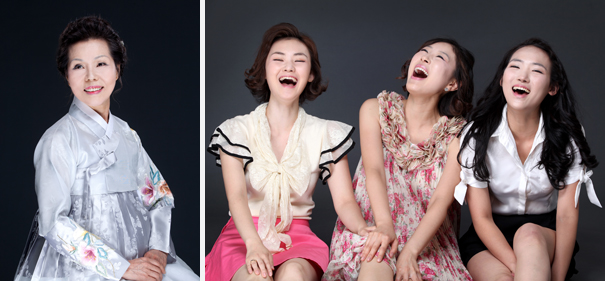‘Come with the Wind’ fuses gugak with pop

Lee Chun-hee, left, and the three actresses who will play the gugak, or traditional Korean music, singer in the “Come with the Wind” performance at the National Gugak Center in Seocho-dong, southern Seoul Provided by the organizer
Lee Chun-hee had always wanted to be a singer. She was drawn to the stage with a passion for pop music and all the fame and glamor that come with the genre.
But fate had a different plan for the musician. She learned and perfected gugak, traditional Korean music, leading her down a path that was not nearly as glamorous as the 2NE1s and Girls’ Generations of the Korean Wave.
After enduring the hardship, Lee became Korea’s best in Gyeonggi Minyo - “Minyo” referring to Korean folk singing and “Gyeonggi” to the province.
She was named Korea’s Important Intangible Cultural Property No. 57 and is now the artistic director of the Folk Music Group within Korea’s National Gugak Center.
Come next month, people will be able to experience the life story of Lee in a rare, experimental performance that blends gugak with drama called “Come with the Wind.”
One could say it’s the Korean version of a Broadway musical. And it’s okay if you are not a big fan of gugak because organizers have thrown in a mix of pop music, theatrics, percussion and trot, a Korean genre influenced by Japan’s enka.
“There have been many attempts in the past to merge gugak with other genres of performing arts,” said Kang Hyun-jun, the spokesman of Yumin, the organizer.
“But we believe this is different in that it’s a drama that has a strong, intense plot and accentuates the beauties of Gyeonggi Minyo.”
In the performance, Lee is taught how to sing by the legendary master of Gyeonggi Minyo Ahn Bi-chwi (1926-92), but stricken from stage fright, she screws up her debut performance. She beats herself up, not eating or drinking as punishment.
But her master scolds her, saying “You said you will impress the whole nation with your singing, but you can’t even impress one audience.” Lee takes opium to get back on stage, but Ahn again denounces her, saying “a singer who can’t sing without opium is not a singer.”
As she overcomes the fear and reliance on opium and mesmerizes the crowd in her first solo concert, she tells the crowd “singing to me is like water, air and life. It makes me live.”
Perhaps what is most intriguing about “Come with the Wind” is how two of Lee Chun-hee’s actual students - Lee Mi-ri and Seong Seul-gi - as well as another actor Jeong Yu-na will play the role of Chun-hee.
In the last scene, Lee Chun-hee herself actually appears on stage.
The show is the sixth edition of traditional performing arts branded “Bujihwa.” The first and second renditions had been performed in Korea in July 2011 and January of this year, while the third, fourth and fifth editions have been performed in the Philippines in February and March of this year.
* “Come with the Wind” takes place at 7:30 p.m. on Aug. 17 and at 3 p.m. and 7:30 p.m. on Aug. 18 at the Yeak-dang (Main Theater) of the National Gugak Center in Seocho-dong, southern Seoul. Tickets cost between 20,000 won ($15.57) and 150,000 won. The venue is near exit. No. 5 of Nambu Bus Terminal Station, line No. 3; exit No. 1 of Bangbae Station, line No. 2; and exit No. 1 of Sadang Station, line No. 4.
By Kim Hyung-eun [hkim@joongang.co.kr]










with the Korea JoongAng Daily
To write comments, please log in to one of the accounts.
Standards Board Policy (0/250자)